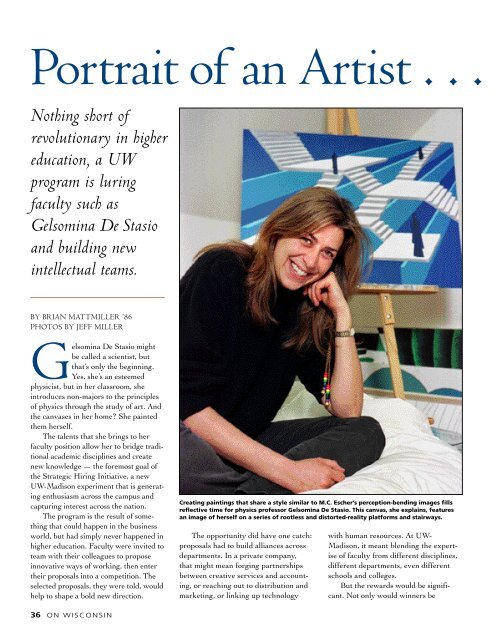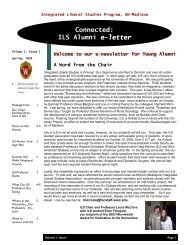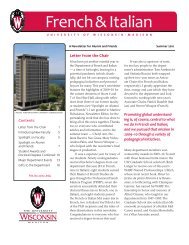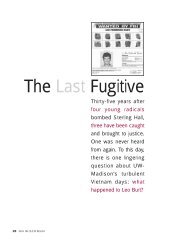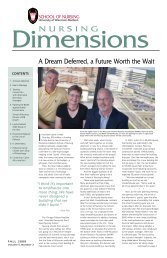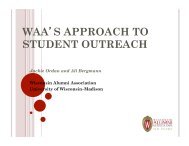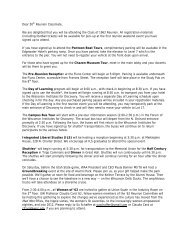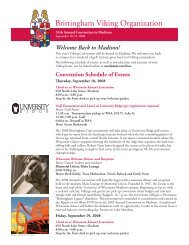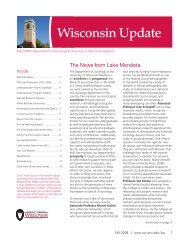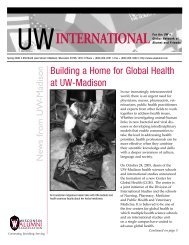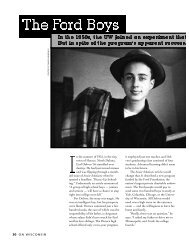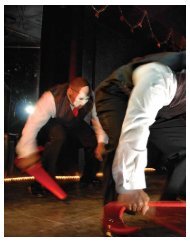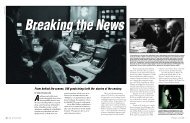Portrait of an Artist...and a Scientist - Wisconsin Alumni Association
Portrait of an Artist...and a Scientist - Wisconsin Alumni Association
Portrait of an Artist...and a Scientist - Wisconsin Alumni Association
- No tags were found...
You also want an ePaper? Increase the reach of your titles
YUMPU automatically turns print PDFs into web optimized ePapers that Google loves.
<strong>Portrait</strong> <strong>of</strong> <strong>an</strong> <strong>Artist</strong> . . .Nothing short <strong>of</strong>revolutionary in highereducation, a UWprogram is luringfaculty such asGelsomina De Stasio<strong>an</strong>d building newintellectual teams.BY BRIAN MATTMILLER ’86PHOTOS BY JEFF MILLERGelsomina De Stasio mightbe called a scientist, butthat’s only the beginning.Yes, she’s <strong>an</strong> esteemedphysicist, but in her classroom, sheintroduces non-majors to the principles<strong>of</strong> physics through the study <strong>of</strong> art. Andthe c<strong>an</strong>vases in her home? She paintedthem herself.The talents that she brings to herfaculty position allow her to bridge traditionalacademic disciplines <strong>an</strong>d createnew knowledge — the foremost goal <strong>of</strong>the Strategic Hiring Initiative, a newUW-Madison experiment that is generatingenthusiasm across the campus <strong>an</strong>dcapturing interest across the nation.The program is the result <strong>of</strong> somethingthat could happen in the businessworld, but had simply never happened inhigher education. Faculty were invited toteam with their colleagues to proposeinnovative ways <strong>of</strong> working, then entertheir proposals into a competition. Theselected proposals, they were told, wouldhelp to shape a bold new direction.Creating paintings that share a style similar to M.C. Escher’s perception-bending images fillsreflective time for physics pr<strong>of</strong>essor Gelsomina De Stasio. This c<strong>an</strong>vas, she explains, features<strong>an</strong> image <strong>of</strong> herself on a series <strong>of</strong> rootless <strong>an</strong>d distorted-reality platforms <strong>an</strong>d stairways.The opportunity did have one catch:proposals had to build alli<strong>an</strong>ces acrossdepartments. In a private comp<strong>an</strong>y,that might me<strong>an</strong> forging partnershipsbetween creative services <strong>an</strong>d accounting,or reaching out to distribution <strong>an</strong>dmarketing, or linking up technologywith hum<strong>an</strong> resources. At UW-Madison, it me<strong>an</strong>t blending the expertise<strong>of</strong> faculty from different disciplines,different departments, even differentschools <strong>an</strong>d colleges.But the rewards would be signific<strong>an</strong>t.Not only would winners be36 ON WISCONSIN
<strong>an</strong>d a <strong>Scientist</strong>“Knowledge once gained casts a light beyond its immediate boundaries.”— JOHN TYNDALL, NINETEENTH-CENTURY BRITISH PHYSICISTrewarded with a green light to implementtheir ideas, they’d also get fundingfor enough new positions to have a realshot at succeeding.Faculty jumped at the opportunity.In the first year alone, more th<strong>an</strong> onehundred hiring proposals were submittedby interdisciplinary teams involvingmore th<strong>an</strong> four hundred faculty. Now inits third year, the initiative, known internallyas “cluster hiring,” has supportedninety new positions — but that onlyscratches the surface <strong>of</strong> its impact. Theprogram represents <strong>an</strong> approach that isnothing short <strong>of</strong> revolutionary in therealm <strong>of</strong> higher education.Renaiss<strong>an</strong>ce <strong>Scientist</strong>“My ideal scientist is Leonardo daVinci,” says De Stasio, a native <strong>of</strong> Rome,Italy. “He could move 360 degrees, beinterested in m<strong>an</strong>y different disciplines atone time, <strong>an</strong>d excel in all <strong>of</strong> them.”Just as Leonardo melded a passionfor painting with his exp<strong>an</strong>sive mindfor invention, De Stasio also coversdivergent ground.The 1999 addition to the physicsdepartment belongs to a cluster hiringarea called biophotonics. Her group isconcerned with the development <strong>of</strong> newmicroscopes that peer deeply into theinner workings <strong>of</strong> cells. De Stasio’s ownmicroscope, nicknamed Mephisto, iscurrently one <strong>of</strong> the highest-resolutionx-ray microscopes in the world.She spends a lot <strong>of</strong> her time at theSynchrotron Radiation Center inStoughton, <strong>an</strong> underground electronaccelerator ring that helps to illuminatesome <strong>of</strong> the invisible forces <strong>of</strong> nature.De Stasio’s quarry is a cure for c<strong>an</strong>cer.Using Mephisto to illuminate c<strong>an</strong>cercells, De Stasio is examining a new type<strong>of</strong> c<strong>an</strong>cer therapy that could virtuallyeliminate the collateral damage thatoccurs from chemotherapy or radiationtreatment. The therapy involves <strong>an</strong>uclear reaction that causes the equivalent<strong>of</strong> a tiny atomic bomb to detonateinside each c<strong>an</strong>cer cell.She is collaborating with MineshMehta, a UW Medical School radiationtherapy expert, to perfect the process.A high-energy personality known bynearly everyone as “Pupa,” De Stasio<strong>an</strong>d her graduate students frequentlywork around the clock during thethree-week windows when her project isonline. She’s always on the lookout forgood twenty-four-hour diners.After working for a decade splittingtime among Madison, Rome, <strong>an</strong>dLaus<strong>an</strong>ne, Switzerl<strong>an</strong>d, De Stasio hascome to appreciate the comparativelystaid faculty life. Her course seemsalmost tailor-made for her: Physicsin the Arts, a highly visual approach tophysics designed for non-majors. Everyclass she teaches comes with a constellation<strong>of</strong> PowerPoint slides, which usesome <strong>of</strong> her favorite works <strong>of</strong> art toillustrate light, perspective, pigment,<strong>an</strong>d other principles.De Stasio says the strategic hiringapproach was ultimately why she choseUW-Madison over <strong>an</strong>other job <strong>of</strong>fer atCalifornia’s Jet Propulsion Laboratory,which w<strong>an</strong>ted her to develop newexperiments for future NASA spacemissions.“It’s a brilli<strong>an</strong>t initiative, especiallythe interdisciplinary approach,” she says.“The more we progress with science, themore there is to do. Whatever is left willrequire the cooperation <strong>of</strong> specialistsfrom different disciplines.”Faculty attending a noon-hour Chaos <strong>an</strong>d Complex Systems seminar in Chamberlin Halllearn about De Stasio’s research, which, in collaboration with a Medical School colleague,is examining a new type <strong>of</strong> c<strong>an</strong>cer therapy.SPRING 2001 37
Catalyst forCollaborationThe new hiring approach has triggeredhundreds <strong>of</strong> faculty collaborations, leadingto knowledge that is wholly original<strong>an</strong>d <strong>of</strong>ten counter-intuitive. Most import<strong>an</strong>tly,it helps faculty who are teaching<strong>an</strong>d researching to a way to better<strong>an</strong>ticipate the ch<strong>an</strong>ging needs <strong>of</strong> society.It’s being held up as a template forthe twenty-first-century university,attracting attention across the country.Donna Shalala, former UW-Madisonch<strong>an</strong>cellor <strong>an</strong>d former U.S. secretary <strong>of</strong>Health <strong>an</strong>d Hum<strong>an</strong> Services who is nowthe president <strong>of</strong> Miami University, callsit the most exciting experiment takingplace in higher education today.“I think this is going to becomepart <strong>of</strong> the culture here,” says Ch<strong>an</strong>cellorJohn Wiley MS’65, PhD’68, who,along with former Ch<strong>an</strong>cellor DavidWard MS’62, PhD’63, is the program’sprimary architect. “We initiated this fromthe top down, but it has been sustainedfrom the bottom up. It’s the enthusiasm<strong>of</strong> the faculty that has kept it going.”Sus<strong>an</strong> Friedm<strong>an</strong>, <strong>an</strong> English <strong>an</strong>dwomen’s studies pr<strong>of</strong>essor <strong>an</strong>d one <strong>of</strong>the program’s early particip<strong>an</strong>ts, saysit is allowing faculty to venture intouncharted intellectual territory. “Instead<strong>of</strong> having administrators issue nice ideasabout how departments should hire differentkinds <strong>of</strong> people,” Friedm<strong>an</strong> says,“there was a carrot there — a big carrot— <strong>an</strong>d that was faculty [positions], aprecious commodity on campus.”During the program’s first threeyears, the university has funded thirtytwocluster hiring proposals, usually withthree or four positions attached. Theybuild their expertise around <strong>an</strong> intellectualchallenge, a technological opportunity,or <strong>an</strong> emerging social problem.The proposals reflect a smorgasbord<strong>of</strong> academic fields. Of those funded s<strong>of</strong>ar, fifteen have their roots in the arts,hum<strong>an</strong>ities, or social sciences, while theother seventeen are rooted in the physicalor biological sciences.One new cluster is genomics, whichis helping to gle<strong>an</strong> relev<strong>an</strong>ce from theDuring a break between teaching back-to-back classes, De Stasio looks over questions for <strong>an</strong>upcoming exam with teaching assist<strong>an</strong>t Evelina Tsoncheva outside Sterling Hall.billions <strong>of</strong> bits <strong>of</strong> DNA code spinning out<strong>of</strong> sequencing efforts. Other vital newareas include international public affairs<strong>an</strong>d global cultural affairs, both <strong>of</strong> whichhave been drastically reshaped by globalization.Another effort centers aroundn<strong>an</strong>otechnology, the science <strong>of</strong> rearr<strong>an</strong>gingatoms to construct entirely newmaterials. Other examples includebiotechnology ethics, sustainable l<strong>an</strong>duse, energy sources <strong>an</strong>d policy, <strong>an</strong>d theinformation technology revolution.The program is adding some newstars to UW-Madison’s academic galaxyby attracting people at the pinnacle <strong>of</strong>their fields. David Schwartz, a pr<strong>of</strong>essorfrom New York University who joinedthe genomics group in 1999, invented atechnology called optical mapping that isnow the gold st<strong>an</strong>dard for genomicsresearch worldwide. And psychologypr<strong>of</strong>essor Mark Seidenberg, recruitedfrom the University <strong>of</strong> Southern California,is one <strong>of</strong> the world’s leading scientistsexploring the cognitive roots <strong>of</strong> l<strong>an</strong>guage.Linda Greene, associate vice ch<strong>an</strong>cellor<strong>an</strong>d the program’s coordinator,says that strategic hiring has probablyinfluenced those already on the facultyeven more th<strong>an</strong> newcomers. “The veryprocess <strong>of</strong> competing for the clusterhires brings our faculty together towork across departments [<strong>an</strong>d] acrossdisciplines to envision the ways in whichour curriculum <strong>an</strong>d our research c<strong>an</strong> beenriched,” she says.Reloading theFaculty R<strong>an</strong>ksUW-Madison’s strategic hiring opportunitycame on the heels <strong>of</strong> a decade <strong>of</strong>attrition in the faculty r<strong>an</strong>ks, Wiley says.Throughout the 1990s, the universitysimply didn’t have the money to replacefaculty members who were leaving forretirement or outside <strong>of</strong>fers. From 1988to 1998, faculty numbers dropped toabout 2,100, a loss <strong>of</strong> 250 faculty.Ward, who was ch<strong>an</strong>cellor at thetime, <strong>an</strong>d Wiley, who was serving asprovost, recognized that it was imperativeto begin rebuilding the faculty toacceptable levels. They set a goal <strong>of</strong>adding approximately 150 faculty. Thequestion was how. Wiley noted that thefaculty losses occurred uniformly acrossnearly every department on campus.Simply doling out new positions, one perdepartment, seemed like squ<strong>an</strong>dering<strong>an</strong> opportunity.Departments also tend to perpetuatethe status quo by seeking faculty who areapproximate clones <strong>of</strong> the people theyreplace. “An expert in area A getsreplaced by <strong>an</strong>other expert in area A,”Wiley says. “That’s one <strong>of</strong> the reasonswhy universities ch<strong>an</strong>ge so slowly.“So what we decided to do,” Wileyexplains, “was throw it wide open to thecampus <strong>an</strong>d ask them: if you had three orfour new positions for one concentrated38 ON WISCONSIN
area, what area do you think would bemost import<strong>an</strong>t to focus on?”The idea <strong>of</strong> a campus competitionwas born, albeit with a modest start. In1998, the university had funding only fora dozen new positions, <strong>an</strong>d most <strong>of</strong> thosewere cobbled together from existingcollege budgets. But then the idea wasgiven a high-pr<strong>of</strong>ile break: then GovernorTommy Thompson ’63, JD’66 heardabout the pl<strong>an</strong> <strong>an</strong>d became <strong>an</strong> inst<strong>an</strong>tf<strong>an</strong>. Wiley was called to Thompson’s<strong>of</strong>fice <strong>an</strong>d was allocated eight new positionsworth $1.5 million — right in themiddle <strong>of</strong> a budget biennium — to befocused on booming fields in the biosciences.Now, with twenty new positions<strong>an</strong>d a clear sense <strong>of</strong> greater publicsupport, the competition got interesting.Today the program has beenextended <strong>an</strong>d will generate as m<strong>an</strong>y as125 new positions, th<strong>an</strong>ks primarily tosupport from a four-year pl<strong>an</strong> called theMadison Initiative. Strategic hiring wasone <strong>of</strong> four initial funding priorities <strong>of</strong>the $97 million initiative, which proposesmatching state money with support fromthe UW Foundation <strong>an</strong>d the <strong>Wisconsin</strong><strong>Alumni</strong> Research Foundation.The primary attraction, Wiley says, isnot just gaining a new faculty position. Itis being able to promote a ground swell<strong>of</strong> new interdisciplinary interests.“The new positions will representonly about 6 percent <strong>of</strong> our total faculty,”Wiley says, “but this was a way <strong>of</strong> havinga huge multiplier effect.”A Century<strong>of</strong> TunnelingNone <strong>of</strong> this crosswiring <strong>of</strong> disciplineswould be possible, <strong>of</strong> course, had theacademic department not emerged a centuryago as the domin<strong>an</strong>t structural forcebehind Americ<strong>an</strong> higher education.Clifton Conrad, a UW-Madison pr<strong>of</strong>essor<strong>of</strong> higher education, says departmentswere borrowed from the Germ<strong>an</strong>university model in the mid-1800s. Theyrepresented <strong>an</strong> entirely new <strong>an</strong>d progressiveapproach to the university: a placethat would provide a core curriculum<strong>an</strong>d a broad r<strong>an</strong>ge <strong>of</strong> specialized studies.It’s celebration time for De Stasio, at left, after data suggests a breakthrough in her research at theSynchrotron Radiation Center. She enjoys the moment with Tizi<strong>an</strong>a Parasassi, a colleague from the NationalResearch Council, center, <strong>an</strong>d graduate student Brad Frazer. With its claustrophobic maze <strong>of</strong> wires <strong>an</strong>dstainless steel chambers, the center is <strong>an</strong> international destination for hard-core physicists <strong>an</strong>d engineers.Departments would be built around thegoal <strong>of</strong> adv<strong>an</strong>cing knowledge for thegreater good <strong>of</strong> society.Prior to that time, Conrad says,colleges were based on a rigid medievalstructure. Their purpose was the training<strong>of</strong> “Christi<strong>an</strong> gentlemen,” with a curriculumrooted in the twin pillars <strong>of</strong> thetrivium (grammar, rhetoric, logic) <strong>an</strong>dthe quadrivium (math, music, geometry,astronomy). Greek <strong>an</strong>d Latin werem<strong>an</strong>datory, <strong>an</strong>d teaching was entirelybased on recitation <strong>an</strong>d memorization.And for exams, students had to suffer apublic exhibition, during which theywere grilled by the college president,tutors, <strong>an</strong>d other “learned gentlemen.”Students were not entirely thrilledwith this suffocating “collegiate way.”Conrad references the Harvard rebellion<strong>of</strong> 1823, a spree <strong>of</strong> rowdyism that endedin the expulsion <strong>of</strong> forty-three <strong>of</strong> the university’sseventy students. Interestingly,student literary societies, debate teams,athletic clubs, <strong>an</strong>d other extracurricularpursuits blossomed during this era.After the Civil War <strong>an</strong>d the L<strong>an</strong>d Gr<strong>an</strong>tAct <strong>of</strong> 1862, universitiesbeg<strong>an</strong> to focus outward,toward meeting thenation’s ch<strong>an</strong>ging needs.Graduate education grewrapidly, <strong>an</strong>d specializedresearch rose in value.Faculty went from beingglorified tutors to “purveyors<strong>of</strong> disciplinaryknowledge,” in positions<strong>of</strong> high esteem. Conradsays this ch<strong>an</strong>ge triggereda period <strong>of</strong> rigorous “verticalexp<strong>an</strong>sion” <strong>of</strong> knowledge— going deeper <strong>an</strong>ddeeper into specializeddisciplines — that existsto this day.Academic departmentsdid great things for education<strong>an</strong>d for the world,Conrad says. They preparedstudents for <strong>an</strong>increasingly complicatedtechnical world, <strong>an</strong>d producedrigorous researchSPRING 2001 39


